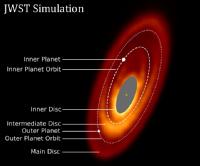Warwick Astronomy Blog
Exploring Warwick Astronomy
This blog collects articles from Warwick Astronomy and Astrophysics group, ranging from advice on home observing, through the history and nature of night sky objects, to accounts of our own research and the life of Warwick Astronomers.
We aim to update this blog on a monthly basis from October 2024
Explaining the intermediate ring around Fomalhaut
Last year, the James Webb Space Telescope sparked discussion when it discovered an unexpected ‘intermediate’ dust ring around the star Fomalhaut. The structure seen by James Webb raises the possibility that there may be unseen planets around Fomalhaut. We investigate whether this could be the case through simulations of the system.
A WarwickAstro blog post Noah Sims, Tim Pearce & Minjae Kim
Rapid-forming giants could disrupt spiral protoplanetary discs
Giant planets that developed early in a star system’s life could solve a mystery of why spiral structures are not observed in young protoplanetary discs, according to a new study by University of Warwick astronomers.
A Warwick press release on work led by our Sahl Rowther.
Planetary Protection: What we still haven't learnt from the moon
In the early years of the Cold War and the Space Race, the scientific community began to raise concerns that in the rush to be the first nation to reach certain milestones, irrevocable damage could be done to the Solar System... so what have we learnt and what haven't we learnt from the race to the Moon.
Our Catriona MacDonald writes for Warwick's Habitability Global Research Priority programme. Reblogged from the Habitability GRP.
Next-gen astronomical survey makes its first observations toward a new understanding of the cosmos
The newly-launched SDSS-V will continue the path-breaking tradition set by the survey's previous generations, with a focus on the ever-changing night sky and the physical processes that drive these changes, from flickers and flares of supermassive black holes to the back-and-forth shifts of stars being orbited by distant worlds. The project’s consortium includes the University of Warwick, which will lead an observational survey of all stars within 325 light years of the Earth - encompassing 350,000 systems, many of which are likely to host planetary systems.
An astro press release from Warwick's press office focussing on research led by our Prof. Boris Gänsicke.
Dragons in the Sky
In 793CE, monks writing the Anglo-Saxon Chronicle recorded sightings of dragons in the skies above northern England. While the streaks of fire they witnessed were likely the result of a meteor shower or aurorae, they weren’t the first or the last to see dragons in the night sky. Dr Elizabeth Stanway from Warwick’s Astrophysics research group looks at some of the other legends, myths and stories linking dragons and space.
Originally posted on Warwick's Knowledge Centre
The Crucial Need for DebrisWatch
University of Warwick astronomers are warning that orbital debris posing a threat to operational satellites is not being monitored closely enough, as they publish a new survey finding that over 75% of the orbital debris they detected could not be matched to known objects in public satellite catalogues.
A press release from Warwick Newsroom, highlighting work led by our Prof Don Pollaco, Dr Paul Chote and PhD researcher James Blake.
Peering through the Cloud Tops of Exoplanets
University of Warwick astronomers have shown that water vapour can potentially be detected in the atmospheres of exoplanets by peering literally over the tops of their impenetrable clouds.
A Warwick Newsroom Press Release focussing on research led by our Dr Matteo Brogi and Dr Siddharth Gandhi
The Real Tatooines?
From Gallifrey to Tatooine, planets with multiple suns feature widely in science fiction, but there are currently only ten real ‘circumbinary’ planets identified by space scientists. Dr David Armstrong from Warwick’s Astrophysics research group considers what we know about planets with two stars – and asks if life could exist there.
Originally published on Warwick's Knowledge Centre
Potatoes on Mars?
Exploring habitability, on our own world and beyond, is a research priority for the University of Warwick and an interest for Warwick's Centre for Exoplanets and Habitability. Our Ares Osborn explores one aspect of this topic - growing food on Mars.
Originally published on Warwick Knowledge Centre

